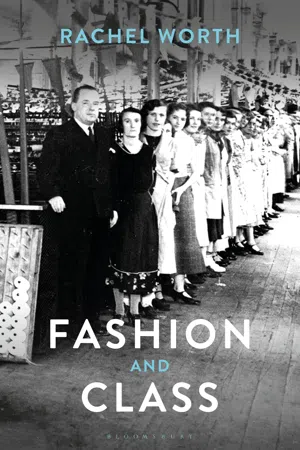History
Sans-Culottes
The Sans-Culottes were a group of radical working-class people who played a significant role in the French Revolution. They were known for their distinctive clothing, which lacked the knee breeches (culottes) worn by the upper classes. The Sans-Culottes were instrumental in the overthrow of the monarchy and the establishment of the First French Republic.
Written by Perlego with AI-assistance
Related key terms
Related key terms
1 of 4
Related key terms
1 of 3
2 Key excerpts on "Sans-Culottes"
- eBook - ePub
- Rachel Worth(Author)
- 2020(Publication Date)
- Bloomsbury Visual Arts(Publisher)
sans culotte s (men in carmagnole jackets and loose-fitting trousers or ‘pantalons’ and both men and women in clogs or ‘sabots’) came to symbolise the emergent cult of working-class dress.The French Revolution did not start a revolution in the way people dressed, but it accelerated and accentuated changes that were already under way.42 Valerie Steele argues that the trend towards plainer clothes had already begun before the occurrence of the French Revolution.43 But in the process the dress of workers, of the poor, of the ‘common people’, was transformed, from constituting, first and foremost, items of functional practicality associated with immediate, everyday experience, to acquiring political and philosophical significance in the wider context of the social life of the French nation. The term sans culotte s utilised the negation of an item of dress (i.e. without the knee-length breeches adopted by the aristocrats and bourgeoisie and in favour of the loose-fitting, utilitarian long trousers or ‘pantalons’) to describe a whole class of formerly politically dispossessed people: manual labourers and the urban poor. As Roche observes, the Revolution established trousers as the symbolic garment of the sans culotte s of 1793 although it is something of a mystery that, possibly sold or buried, they are rarely found in surviving inventories (Figure 2.7 ). From pictorial sources it would appear that breeches finally ceased to be worn in the 1820s, other than at official ceremonies.44 But it is the symbolism of the references to clothing that became so powerful, linking fashion and class inextricably. Maximilien de Robespierre, meanwhile, calling himself the leader of the sans culotte - eBook - ePub
- Norman Hampson(Author)
- 2008(Publication Date)
- Routledge(Publisher)
Sans-Culottes were given preference in appointments and the War Office became a stronghold of the popular movement.The Sans-Culottes achieved more than an improvement in their standard of living and access to occupations which had previously been closed to them. In the provinces in particular they frequently came to exercise a good deal of power. Representatives on mission, exasperated by the lethargy of their Departments, the silent hostility of local notables who had often declared for the Girondins, and the widespread evasion of revolutionary controls, drastically purged the local authorities, substituting men recommended by the local Clubs and often looking to the sansculottes for the energy that they found lacking amongst the educated. Although policy varied with the individual deputy and with local conditions, there were many who agreed with the agent of the Minister of the Interior who wrote on 24th September, ‘I think the majority of the municipalities need to be changed so as to exclude big landowners and farmers who keep the other citizens in a state of dependence so that they don’t dare to say a word.’ These tactics were applied with a will during the autumn of 1793. At Nantes the bourgeois town council gave way to a municipality that included many Sans-Culottes and no wealthy merchants.2 In the pays de Caux, in the Dieppe area, the municipalities, especially in the country districts, were controlled by daylabourers and town-meetings were boycotted by the yeomen farmers. At Rodez, Taillefer set up a sans-culotte commission to purge the local administration. It must not be thought that the term ‘sans-culotte’ referred merely to the political opinions of the men who now took charge of local government. There is plenty of evidence to show that the new men were, in fact, often drawn from the poorer classes of society.1 At Bourg the majority of the municipal council was illiterate and the same was true of most of the rural Communes in the Moulins area. At Pont Audemer, in Normandy, a justice of the peace could read only with difficulty, and in the Eure two of the six members of the provisional committee in charge of the whole Department could barely sign their names. Representatives on mission, often covering two or more Departments, could exercise only a rough-and-ready control over the local authorities and frequently delegated wide powers to their local agents. In the Cher, for example, Laplanche authorized individual members of the Bourges Club to purge the staff of the civil and military administration and to impose revolutionary taxes on the rich. In many cases, therefore, the Sans-Culottes
Index pages curate the most relevant extracts from our library of academic textbooks. They’ve been created using an in-house natural language model (NLM), each adding context and meaning to key research topics.
Explore more topic indexes
Explore more topic indexes
1 of 6
Explore more topic indexes
1 of 4

